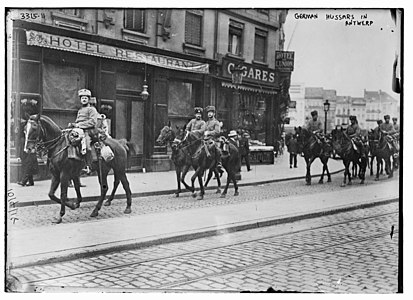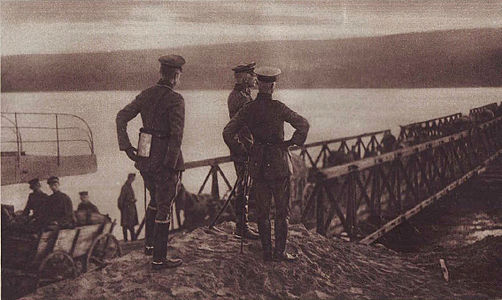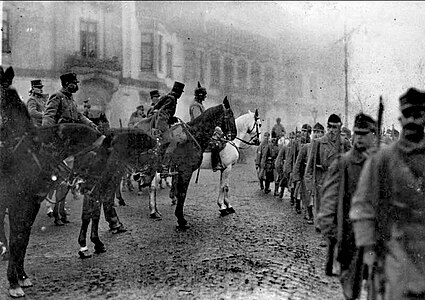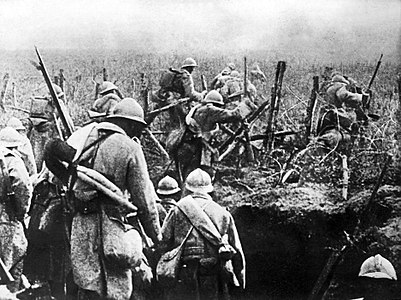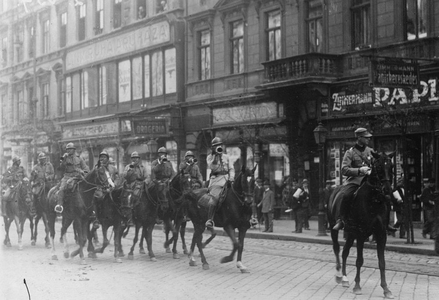Marsh Wars (Pacifica): Difference between revisions
No edit summary Tag: 2017 source edit |
No edit summary Tag: 2017 source edit |
||
| Line 29: | Line 29: | ||
'''Second Marsh War:''' | '''Second Marsh War:''' | ||
* Stoinian victory | * Stoinian victory | ||
* Displacement of 180,000 Ezervulgish | |||
* {{Pacifica|Treaty of Kétvár}} | * {{Pacifica|Treaty of Kétvár}} | ||
| status = | | status = | ||
| Line 36: | Line 37: | ||
| combatant3 = | | combatant3 = | ||
| commander1 = {{flagicon|Stoinia}} '''Alexandru VIII'''<br/>{{flagicon|Stoinia}} Field Marshal {{Pacifica|Sergiu Vernescu}}<br/>{{flagicon|Stoinia}} General {{Pacifica|Jorge Aranda}}<br/>{{flagicon|Stoinia}} General {{Pacifica|Ramiro De Sarro}} | | commander1 = {{flagicon|Stoinia}} '''Alexandru VIII'''<br/>{{flagicon|Stoinia}} Field Marshal {{Pacifica|Sergiu Vernescu}}<br/>{{flagicon|Stoinia}} General {{Pacifica|Jorge Aranda}}<br/>{{flagicon|Stoinia}} General {{Pacifica|Ramiro De Sarro}} | ||
| commander2 = {{flagicon|Ezervulge}} '''George II'''<br/>{{flagicon|Ezervulge}} Field Marshal {{Pacifica|Mákkeszőr Ámbrus}}<br/>{{flagicon|Ezervulge}} General {{Pacifica|Horváth László}}<br/>{{flagicon|Ezervulge}} General {{Pacifica|Szalai Dénes}} | | commander2 = {{flagicon|Ezervulge}} '''George II (Gyorgy II)'''<br/>{{flagicon|Ezervulge}} Field Marshal {{Pacifica|Mákkeszőr Ámbrus}}<br/>{{flagicon|Ezervulge}} General {{Pacifica|Horváth László}}<br/>{{flagicon|Ezervulge}} General {{Pacifica|Szalai Dénes}} | ||
| commander3 = | | commander3 = | ||
| units1 = | | units1 = | ||
| Line 53: | Line 54: | ||
==Background== | ==Background== | ||
Both {{Pacifica|Stoinia}} and {{Pacifica|Ezervulge}} had become industrialised societies following the industrial revolution. However, the Ezervulgish King {{Pacifica|Gyorgy II|George II}} sought a policy of pan-Ezervulgism which brought it head-to-head with {{Pacifica|Stoinia}} which housed some 300,000 Ezervulgish in the {{Pacifica|Loreto}}, {{Pacifica|Corrientes}} and {{Pacifica|Norano}} provinces since the {{Pacifica|Hunyars}}' {{Pacifica|Sacking of Tolosa}}. These border provinces, in addition to hosting Ezervulgish minorities, were rich in coal and steel mines which would help fuel the further industrialisation of {{Pacifica|Ezervulge}}. It was hoped that | Both {{Pacifica|Stoinia}} and {{Pacifica|Ezervulge}} had become industrialised societies following the industrial revolution. However, the Ezervulgish King {{Pacifica|Gyorgy II|George II}} sought a policy of pan-Ezervulgism which brought it head-to-head with {{Pacifica|Stoinia}} which housed some 300,000 Ezervulgish in the {{Pacifica|Loreto}}, {{Pacifica|Corrientes}} and {{Pacifica|Norano}} provinces since the {{Pacifica|Hunyars}}' {{Pacifica|Sacking of Tolosa}}. King {{Pacifica|Gyorgy II|George II}} wished to establish a dominant Bailtemmic nation with all Ezervulgish people under one rule. These border provinces, in addition to hosting Ezervulgish minorities, were rich in coal and steel mines which would help fuel the further industrialisation of {{Pacifica|Ezervulge}}. It was hoped that their incorporation would resurge {{Pacifica|Ezervulge}} as a Bailtemmic power since the defeat in {{Pacifica|Peter I's War}} as well as serve as a long-term economic investment to consolidate Ezervulgish prosperity, which in turn would again strengthen the position of the Ezervulgish King. | ||
{{Pacifica|Stoinia}} was focusing on its overseas territories through industrial development programs. Especially {{Pacifica|Shai Kong}}'s harbour expansion had become a priority against {{Pacifica|Huawan|Paeonisian}} and {{Pacifica|Izaakian}} competition as {{Pacifica|Stoinia}} wished to maintain its role in global trade. Recently, {{Pacifica|Shai Kong}} had become overcrowded and the lacking infrastructure had made {{Pacifica|Hai Men Island}} a preferable choice over {{Pacifica|Shai Kong}}. This required government intervention overseas to fully develop {{Pacifica|Corinia|Corinian}} industries so that they may operate autonomously. In addition, citizens overseas had grown their own identities which had caused incidents of rebellion. As such, {{Pacifica|Prime Minister of Stoinia|Prime Minister}} {{Pacifica|Tiberiu Stolojan}} frequently voyaged to {{Pacifica|Corinia}} and {{Pacifica|Carraca}} to oversee the industrialisation of the overseas territories. This would however invite Ezervulgish opportunism. | |||
{{Pacifica|Stoinia-Ezervulge relations|Stoino-Ezervulgish relations}} would start to deteriorate from 1908 and Ezervulgish Ambassadors would become increasingly volatile and propagate stories of how Ezervulgish in Stoinia are abused by Stoinian governance. Later studies would show that Ezervulgish marginalisation happened due to significant language barriers in local administrations. Nonetheless, the Ezervulgish rhetoric only grew more zealous over the years until it reached a breaking point on 5 September 1914 when {{Pacifica|Ezervulge}} formally declared war with the intent to liberate the Ezervulgish minority in {{Pacifica|Stoinia}}. | |||
==Strategy== | ==Strategy== | ||
===Stoinia=== | ===Stoinia=== | ||
[[File:Romanian Officers WWI.jpg|center|thumb|300x300px|Stoinian Royal Army Generals during a military parade in 1909.]] | |||
===Ezervulge=== | ===Ezervulge=== | ||
[[File: | |||
[[File:August von Mackensen in Sofia 1916.jpg|center|thumb|Ezervulgish military staff with King George II.]] | |||
==Events== | ==Events== | ||
===First Marsh War=== | ===First Marsh War=== | ||
<gallery mode="packed" gallery widths="200" heights="200" caption="Villámló Ló offensive"> | |||
General Feldmarschall August Von Mackensen (cropped).png|A portrait of Field Marshal {{Pacifica|Mákkeszőr Ámbrus}} in {{Pacifica|Hunyászok}} uniform in 1914. | |||
German Hussars in Antwerp LCCN2014703586.jpg|thumb|Ezervulgish {{Pacifica|Hunyászok}} in {{Pacifica|Noreña}}, November 1914. | |||
FM Mackensen on the Romanian side..JPG|Field Marshal {{Pacifica|Mákkeszőr Ámbrus}} at the Crossing of the Narcea, following the Battle of Carreño. | |||
Bundesarchiv Bild 183-R36187, Bukarest, Parade einziehender Truppen.jpg|Field Marshal {{Pacifica|Mákkeszőr Ámbrus}} inspecting his troops in {{Pacifica|Carreño}}. | |||
</gallery> | |||
===Second Marsh War=== | ===Second Marsh War=== | ||
<gallery mode="packed" gallery widths="200" heights="200" caption="Caballo Salvaje offensive"> | |||
Bataille de Verdun 1916.jpg|Stoinian trench offensive. | |||
Tropas-rumanas-cárpatos--rumaniassacrific00neguuoft.png|Stoinian III Army marching through Varcathian mountain passes to flank Ezervulgish lines. | |||
RomanianCavalryBudapest.png|Stoinian cavalry in Sárkanyvölgy. | |||
</gallery> | |||
==End of Wars== | ==End of Wars== | ||
| Line 73: | Line 91: | ||
==Aftermath== | ==Aftermath== | ||
===Controversy=== | |||
<!-- Tribunates not granted when created as too few Ezervulgish in spread out communities, left the Ezervulgish disgruntled for their own Tribunate--> | |||
Revision as of 00:07, 21 October 2023
| Marsh Wars | |||||||
|---|---|---|---|---|---|---|---|
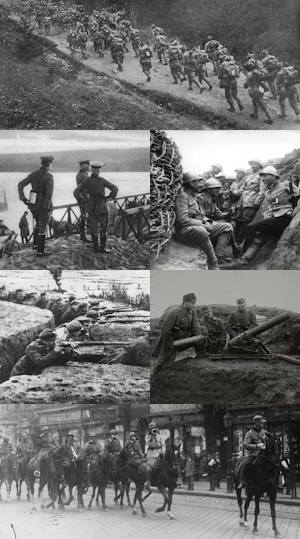 (clockwise)
| |||||||
| |||||||
| Main belligerents | |||||||
|
|
| ||||||
| Commanders and leaders | |||||||
|
|
| ||||||
| Strength | |||||||
|
|
| ||||||
| Casualties and losses | |||||||
|
287,000 killed 380,000 wounded |
296,000 killed 320,000 wounded | ||||||
The Marsh Wars (Castonish: Guerras de las Marismas; Ezervulgish: Mocsarak háborúi) were a series of conflicts in the early 20th century as a result of a decade of crumbling Stoino-Ezervulgish relations. Open hostilities began on 5 September 1914 and would be marked by both swithering and static frontlines until 13 November 1918. The war would be named after the formation of marshes due to extreme weather conditions elevated through trench warfare. The conflict was one of Pacifica's first wars with the widespread use of trenches, chemical weapons and modern equipment.
Background
Both Stoinia and Ezervulge had become industrialised societies following the industrial revolution. However, the Ezervulgish King George II sought a policy of pan-Ezervulgism which brought it head-to-head with Stoinia which housed some 300,000 Ezervulgish in the Loreto, Corrientes and Norano provinces since the Hunyars' Sacking of Tolosa. King George II wished to establish a dominant Bailtemmic nation with all Ezervulgish people under one rule. These border provinces, in addition to hosting Ezervulgish minorities, were rich in coal and steel mines which would help fuel the further industrialisation of Ezervulge. It was hoped that their incorporation would resurge Ezervulge as a Bailtemmic power since the defeat in Peter I's War as well as serve as a long-term economic investment to consolidate Ezervulgish prosperity, which in turn would again strengthen the position of the Ezervulgish King.
Stoinia was focusing on its overseas territories through industrial development programs. Especially Shai Kong's harbour expansion had become a priority against Paeonisian and Izaakian competition as Stoinia wished to maintain its role in global trade. Recently, Shai Kong had become overcrowded and the lacking infrastructure had made Hai Men Island a preferable choice over Shai Kong. This required government intervention overseas to fully develop Corinian industries so that they may operate autonomously. In addition, citizens overseas had grown their own identities which had caused incidents of rebellion. As such, Prime Minister Tiberiu Stolojan frequently voyaged to Corinia and Carraca to oversee the industrialisation of the overseas territories. This would however invite Ezervulgish opportunism.
Stoino-Ezervulgish relations would start to deteriorate from 1908 and Ezervulgish Ambassadors would become increasingly volatile and propagate stories of how Ezervulgish in Stoinia are abused by Stoinian governance. Later studies would show that Ezervulgish marginalisation happened due to significant language barriers in local administrations. Nonetheless, the Ezervulgish rhetoric only grew more zealous over the years until it reached a breaking point on 5 September 1914 when Ezervulge formally declared war with the intent to liberate the Ezervulgish minority in Stoinia.
Strategy
Stoinia

Ezervulge

Events
First Marsh War
- Villámló Ló offensive
-
A portrait of Field Marshal Mákkeszőr Ámbrus in Hunyászok uniform in 1914.
-
Field Marshal Mákkeszőr Ámbrus at the Crossing of the Narcea, following the Battle of Carreño.
-
Field Marshal Mákkeszőr Ámbrus inspecting his troops in Carreño.
Second Marsh War
- Caballo Salvaje offensive
-
Stoinian trench offensive.
-
Stoinian III Army marching through Varcathian mountain passes to flank Ezervulgish lines.
-
Stoinian cavalry in Sárkanyvölgy.

